Red Jasper is an opaque Chalcedony that comes in one color and that’s red. Over the last ten years, this material has become quite popular among rock and crystal collectors and I can understand why. The deep red color draws your eyes to it and the high polish gives your eyes a window into the stone.
If you were wondering where the term Jasper originated from then you need to blame the Greeks.
Red Jasper ranges between 6.5 and 7 on the Mohs Hardness Scale. Red is the most common color of Jasper, but it can be found in yellow, green, brown, and rarely blue. Of course, Red Jasper will always be red.
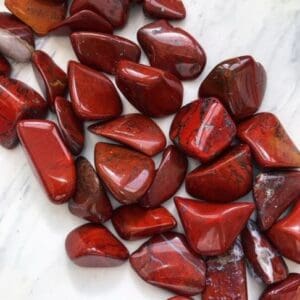
Types of Red Jasper
There are various types of Red Jasper that are found all over the world, with some prime sites in India, Indonesia, Australia, Madagascar, Russia, Brazil, and the United States. In general, Jasper is an impure silicone dioxide with unique patterns that form during mineral consolidation. This occurrence creates various varieties of Jasper.
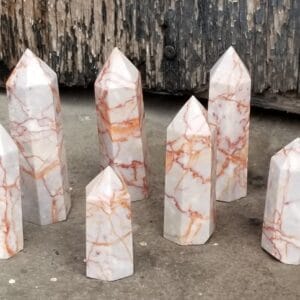
Red Vein Jasper
Red Vein Jasper, otherwise known as Brecciated Jasper, contains Hematite. This iron compound reveals itself through deep red veins and patterns against a beige-colored background. If you look closely you can sometimes see clear crystal inclusions. Most of this material is considered inexpensive and you can find it at your local rock and mineral show.
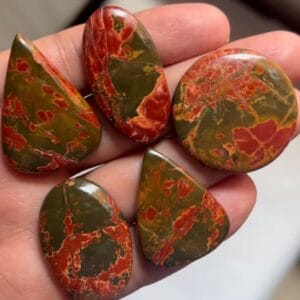
Red Creek Jasper
Red Creek Jasper, aka Cherry Creek Jasper, is a colorful stone discovered in Mainland China in 2010. Miners were searching for Turquoise when they stumbled across this beautiful red, yellow, green, black, and blue-gray stone instead. Similar to Turquoise, Red Creek Jasper must be stabilized to be cut and polished.
This is a relatively new discovery and the material is not readily available but you can source it via online gemstone dealers.
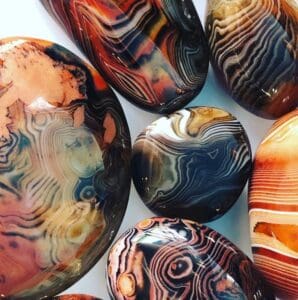
Carnelian vs. Red Jasper
Carnelian and Red Jasper are formed in the same way, which makes them incredibly similar but there are a couple of main differences setting them apart. Keep reading below to learn how to spot the differences quickly and be able to accurately identify rocks.
For starters, Red Jasper is a solid red stone and sometimes it exhibits speckling, whereas Carnelian is more of an orangy brown. Carnelian is going to be more translucent, while Red Jasper is opaque.
Both of these rocks are members of the Chalcedony family, and they’re composed of silicon dioxide. Now we know the chemical make up but what causes the coloring for each stone? Well, it’s going to be iron for both of them.
Unlike Red Jasper, Carnelian can and will have spots caused by inclusions that are easy to spot.
If you’re thinking about doing a hardness test then you shouldn’t. Carnelian and Red Jasper have similar hardnesses which makes this test not very effective.
One more thing we can look at is the way each stone breaks or fractures. Carnelian has an uneven fracture, so it leaves an irregular or rough surface when broken. Jasper has a relatively unique conchoidal fracture, and you can see smooth, curved lines when the stone is broken.
As you can see, the best way to tell the difference between Carnelian and Red Jasper will be a visual inspection.
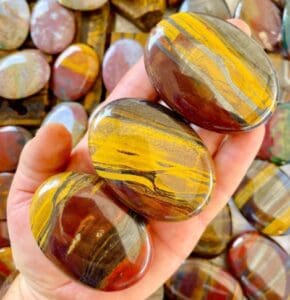
Red and Yellow Jasper
Red and Yellow Jasper or Mookaite Jasper comes in deep red to bright yellow colors with tan, white, pink, purple, and brown. The flow of silica-rich sediments is responsible for determining the patterns of this Jasper variety formed during mineral consolidation. These stones naturally form with cracks and fissures that are later refilled by other minerals, which create a distinct pattern.
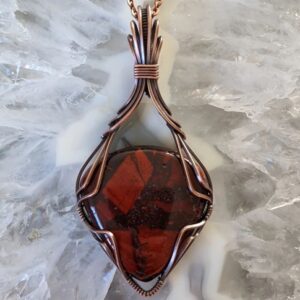
Red Jasper Stone Price
Red Jasper was once a highly sought-after gem but it is much more affordable because of its abundance. The price per gram or pound for Red Jasper will be determined by its form or finished state. For example, a cabochon will cost more per gram than a rough nodule.
If you’re looking for wire wrap jewelry with Red Jasper, then here’s a lovely artist to buy from.
Another visual characteristic to remember is the higher the saturation of red is the more desirable it will be.
- Identify Enstatite - March 12, 2024
- Identify Cerussite - March 3, 2024
- Identify Bytownite - February 18, 2024
